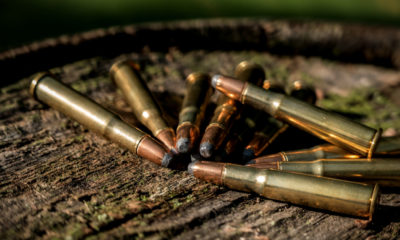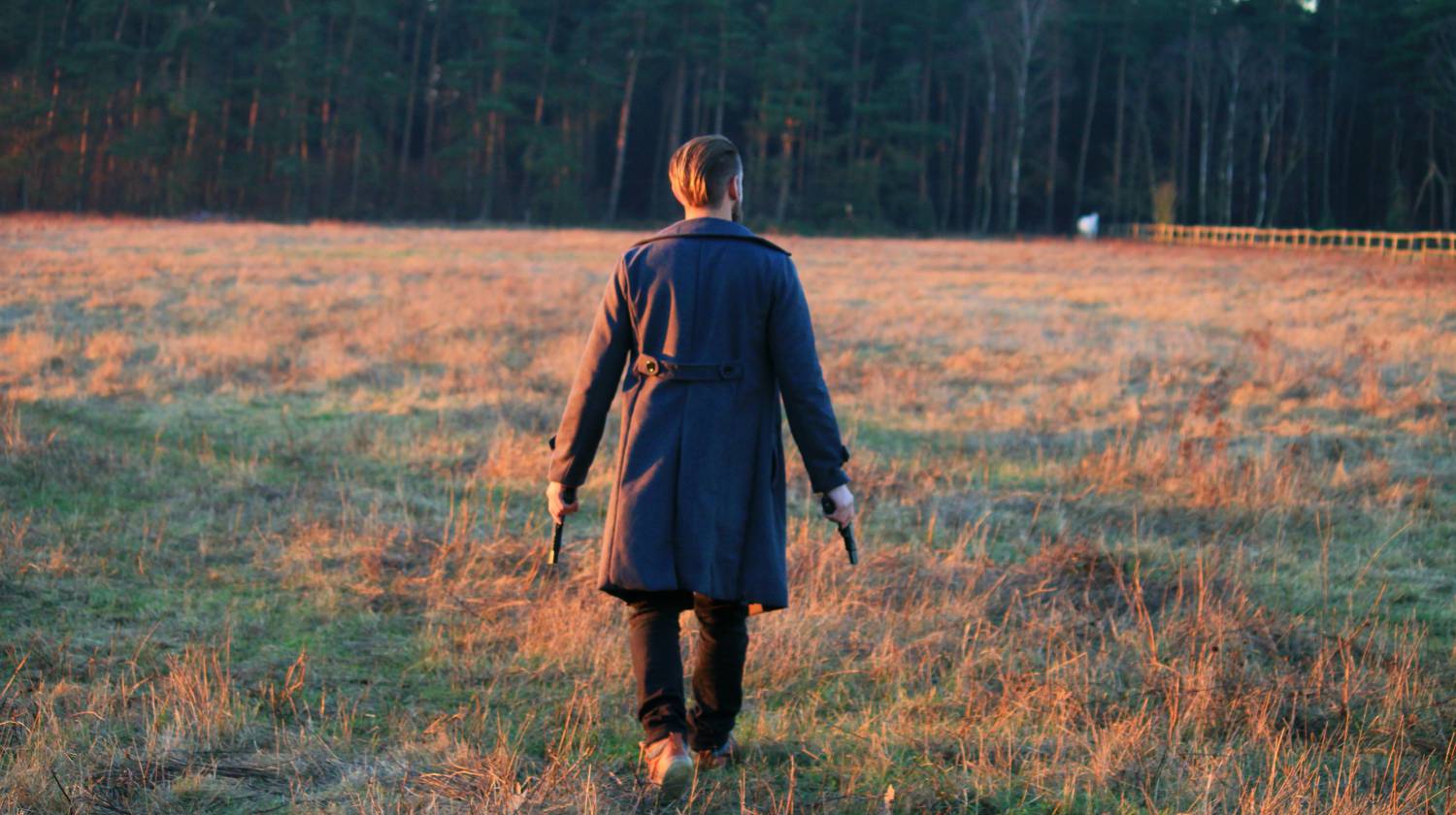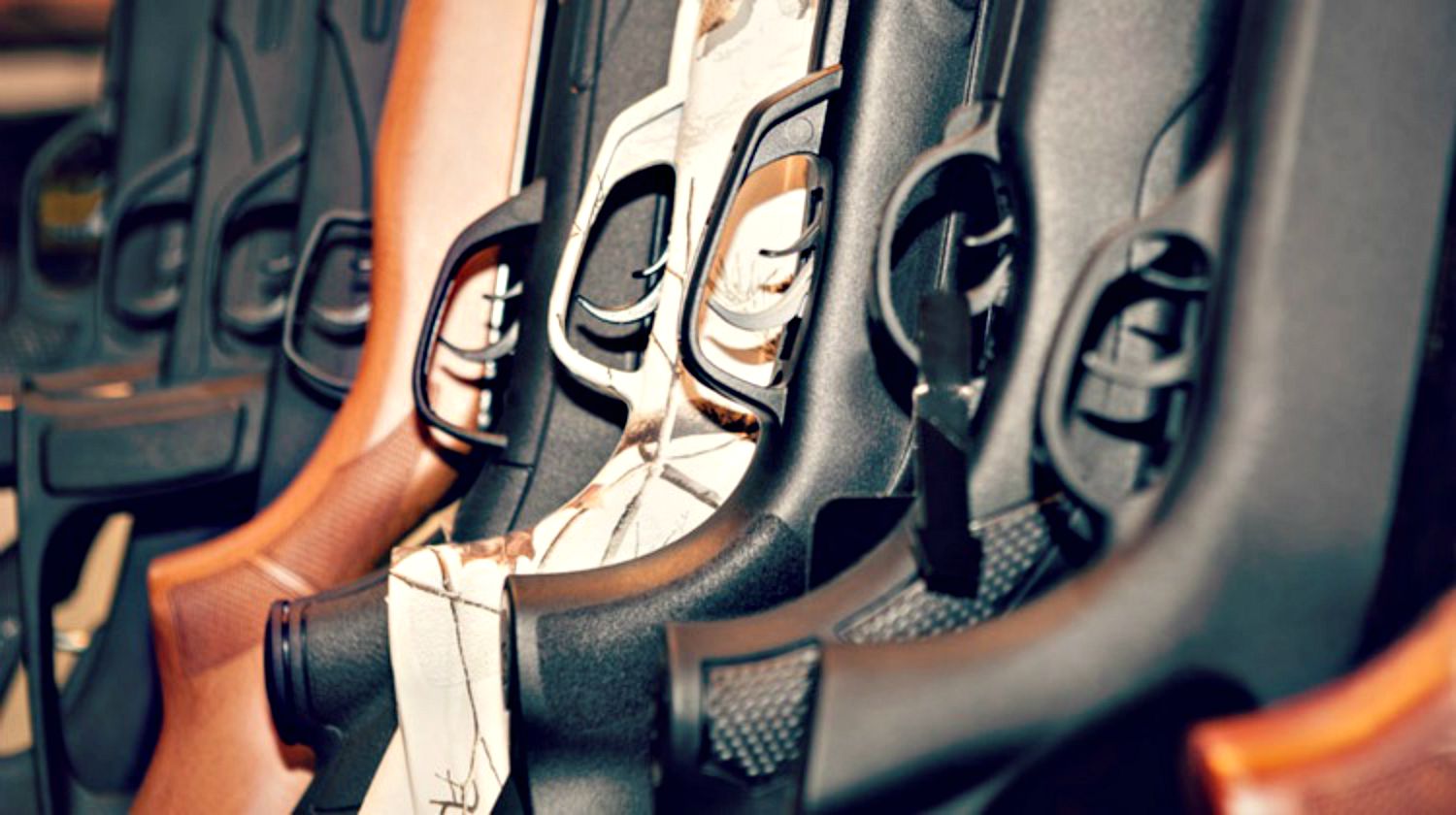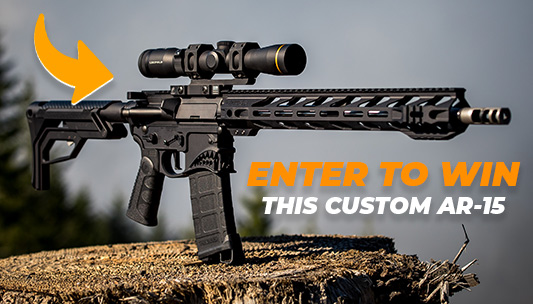Handguns
Selecting Personal Defense Weaponry: Handgun
Published
2 years agoon

In this article, you will learn how to choose the handgun that can protect you and your family.
In this post:
- Many Choices of Handguns
- Switching to a Revolver
- The Best Handguns for Beginners
- Stick to the Basics
- Choosing the Best Handguns for Sale
- The Popularity of the Glock Handguns
- Double-/Single-Action Semi-Auto Handgun
- Should You Buy a Sig?
- When It Means Life and Death
- The Simplicity of the Sig
Which Handgun Will Keep You and Your Family Safe?
Many Choices of Handguns
When it comes to a handgun and weaponry, you have a variety of choices. You'll hear all kinds of opinions about what they use and why their pistol is the best choice.
You'll hear arguments about why the revolver is king or why the semi-auto is superior to it. Different brands of handguns and makes of the same type of firearm, such as the 1911, are better because they say so.
It is a topic people will continue to discuss until firearms are obsolete.
I started my career in law enforcement in 1977. Back then, I carried a Colt 1911A1 Series 70 I had tuned myself. They didn't come with an extended slide stop and safety or beaver-tail grip safeties.
They also didn't have flat mainspring housings, opened ejection ports, or polished ramps. You also couldn't find beveled magazine housings and so on.
Your usual option was to let someone customize your handgun or do it yourself. A lot of the custom pistol smiths got their start back then. Eventually, the manufacturers themselves got onboard with these basic improvements to this proven pistol design.
The 1911A1 is a single-action design. You need to cock the hammer before you fire it. I carried the pistol cocked and locked or “condition one,” according to Gunsite founder and pistol guru Jeff Cooper.
Switching to a Revolver

When I worked as part of the Arizona Highway Patrol, I had to change to a revolver. I used a Smith & Wesson Model 586 .357 and carried my 1911A1 off duty.
I shot both pistols, in stock configuration, no race gun apparel, in the early steel matches. These were my carry guns, and my life depended on them. I wasn't competing to win but to survive.
I did the action work on the Smith, polished it, and tuned it. The Smith revolvers are one of the few makers you can accomplish a good, smooth action/trigger job without weakening the mainspring that fires the cartridge. It's something you do not want to do.
Eventually, we switched over to the German Sig Sauer pistol for uniform carry. It was either in the P220 .45 or the P226 9mm.
The Sig is a Swiss design built by the German Sauer Firearms manufacturer. Swiss law prohibits the export of handguns. The United States makes most Sigs today, which I have mixed feelings about. Most of the time, I have to repair or send a Sig in for warranty work. It's something I have to do with the American-made pistols, never on the German ones.
The Sig P220 handgun I carried and trained with became my primary competition pistol as well. It replaced the 1911A1 and the S&W 586.
During my years in shooting competition, I was firing a thousand rounds a week to prepare for the big shooting matches. More importantly, I intended to make it home at the end of my shift. I worked in a remote part of the state where a backup was 15 to 45 minutes away.
What I'm setting up here is the basis for this discussion and my experience behind it. I owned and shot the 1911 platform and a double-action/single-action revolver platform. I worked with a semi-automatic double-/single-action platform.
The Best Handguns for Beginners

The majority of my LEO career involved the use and carry of the Sig P220. It trained with and shot it steadily until its operation became second nature. Well, what does that mean?
It means once you decided on a pistol you intend to bet your life and your loved ones' lives on, you need to train with it until it becomes second nature to you.
You read the articles in the gun magazines. Almost always, the writer loves the types of guns he is reviewing. Does it make it a good choice for you? Maybe, maybe not.
You'll hear from the experts a beginning shooter should choose a handgun that's manageable. It should not be so complex to use such as a revolver in .22 caliber. This way, they can learn the concepts of shooting.
As a new shooter, you still don't have enough experience with a starter or beginning-level firearm. You can still progress to a real pistol for personal defense later.
Stick to the Basics
Once you chose your handgun, you should remain in the family of the chosen firearm. You can change calibers or even manufacturers. You can also go for the top handguns as long as you stay with the basic design choice.
Let's say you chose a revolver because it is simple and always works. It will often fire from the inside of a pocket or purse without a malfunction. In training, though, you shot mostly a Smith & Wesson or one of the clones out there. It can be a Taurus or Rossi (buy the Smith instead please).
Your friend shows you a nice Colt revolver, perhaps a Python, he picked up. You then decide you like its balance and feel better than the Rossi, Taurus, or even the Smith & Wesson. Maybe it shoots better for you.
What you have to consider is the way these two revolvers function. First is the cylinder release. The Smith you push, and the Colt you pull. It's no big deal, right?
Okay, then you notice the Smith rotates counter-clockwise, and the Colt rotates clockwise. It's still not a problem, right?
You pull the trigger, and they fire. You cock the hammer back to single action, pull the trigger, and they shoot, right? What happens if you need to reload?
It's not that big of a deal in the range. In a threat environment, though, you have the physiological stress that goes with fighting for your life. Are you going to be able to remember which way the cylinder rotates or pushing when you should be pulling the release?
Choosing the Best Handguns for Sale
Both Colt and Smith & Wesson make very good handguns. For some reason, there is a resurgence of interest in them. People are spending god-awful amounts of money buying the classic handguns for sale.
If you're buying a Colt, get the Python. It is hand fitted and one of the best revolvers made, coming standard with a factory-tuned action. As such, you can expect to pay big bucks for one.
You can stick with a Smith L-frame handgun (another term is 586/686). The 586 is blue, and the 686 is stainless steel. The other Colt revolvers are difficult to tune than the Smith, but the Python is from the factory. They are sweet.
Do I own or carry these revolvers? No. Does it mean they're the wrong types of handguns to have? No, it does not. The Python and L frames are .357 magnum chambering. It's still a powerful round for self-defense.
They have a smaller 6- or-7 round capacity and slower reloading time even with speed loaders, though. Some of the L-frame Smiths came with 7-shot cylinders later on.
When you head over to more modern designs, the 1911 platform is one of the reliable, popular handguns today. It is a single-action pistol. You need to cock the hammer before it fires.
After that, barring a malfunction, the pistol will cycle and cock the hammer back, ready for the next round until the gun is empty. When you fire the last shot, the slide locks open for a fast reload.
It seems everyone is making a 1911 now. As long as you stay with a reputable manufacturer, you should be fine. The biggest problem with the 1911 platform is the more you tighten it up for accuracy, the more you remove the number two reason people choose it: reliability.
You have to decide what your intent is with the pistol. The .45 ACP is a known man stopper. I don't have a 1911 in my stable anymore. I sold the last one I owned in the 1980s. There are other single-action semi-autos such as the Browning Hi-Power. It has the same basic design as the Colt 1911. John Browning designed them both.
The Popularity of the Glock Handguns

A Glock handgun is very popular. It is a lightweight, multi-caliber, and configuration pistol that is easy to learn. You can become proficient with it fast. It immediately became popular with law enforcement then and today.
Similar pistols are the S&W M+P and the Springfield XD. They are striker fired, and each shot is the same amount of trigger travel and poundage as the first. They are all in the same family of firearms. Your choice can differ according to how it fits your hand and pricing.
The Springfield XD has a grip safety. All have a trigger safety that releases the lock on the trigger that allows you to fire the pistol. You have to be careful when carrying these concealed weapons.
Pushing them down into your pocket, the back of your pants, or a loose material holster can engage the release. It can then fire the pistol. A few found out about that by shooting themselves in the rear.
Be extra cautious if you change the trigger pull of the Glock to 3.5 pounds from the intended 5-pound pull. The 3.5 is for target shooting, not a carry pistol.
Again, they will keep firing each time you pull the trigger until empty. The slide also locks rearward for a fast reload.
Stay with the name-brand pistols, folks. We're talking about your life and personal defense here. You get what you pay for.
Do I own any of these types of pistols? No, I do not. Are they a bad choice? No, I just don't use them.
RELATED: The Best Handguns For Home Defense
Double-/Single-Action Semi-Auto Handgun

The double-/single-action semi-auto has a history design as long as the 1911's. It started in 1929 and became a favorite of the Germans. It was the basis of the Walther PP, PPK, and later the PPKS platform. The pistol and design continue today, offered by many manufacturers.
Most of the DA/SA pistols have a de-cocker to lower the hammer safely. This way, you can carry the handgun and use it anytime.
There are some that do not and need you to lower the hammer down on a loaded chamber manually. It's a recipe for an unintentional discharge. There are those that have a manual safety as well.
Usually, they are an option rather than a necessity. They will still de-cock the pistol. They will leave the gun on safe. Another way is they move it to the fire position for the double-action first-trigger pull.
The first pull of the trigger is like that of a revolver. It manually cocks and then drops the hammer, firing the pistol.
The pistol cycles. The hammer then remains in a cocking position as it fires subsequent rounds from the lighter trigger pull of single action. To return the pistol to a safe-carry mode, you de-cock the hammer with the safety or de-cocking lever.
Should You Buy a Sig?

When the Arizona Highway Patrol decided on the Sig Sauer P220 and P226 to replace the issued revolvers, I chose the P220. I was carrying the 1911 off duty. I now wanted the stopping power of the .45 round.
Glock was not yet available then. While there were American offers in the same platform as the Sig, these pistols didn't make the grade.
Neither did the Beretta 92. The Sig won the U.S. Military trials, but they chose the Beretta due to cost savings. So Sig it was.
The department issued the handgun to newly graduated officers and senior officers as it labored to obtain more of them. I went out and purchased my Sig P220 for $365.
Don't be too jealous. I fired upward of 60,000 rounds with this pistol and suffered one mechanical failure long after I retired. It was the breakage of the slide stop spring.
Sig recommends changing the springs every 5,000 rounds. I'll say it lasted well beyond its supposed lifespan.
Let me point out the barrel has an Armoloy coating. It is a hard chrome finish. It makes the gun look new, and it doesn't show wear.
I mostly fired 200-grain lead semi-wadcutters I reloaded. It's in addition to the jacketed ammunition we qualified with. Both were remanufactured reloads and factory duty-issued ammunition.
The other metal parts of the pistol, after I worked on the action, came with a ROBAR NP3 coating. It is a Teflon-blended satin nickel finish. Both finishes contributed to the longevity and durability of the already-well-made Sig, which we still shoot.
When It Means Life and Death

Today, I carry a German-made Sig P228 daily with a Walther PPKS as a second backup pistol. Are they the best choice for you? Maybe not, but understand something here.
As an officer, I carried this pistol platform for a minimum of 16 years. I trained with it extensively well as instructed police personnel in its use. I patterned my memory using this pistol design and its method of operation.
Under the stress or threat of an armed assailant attack and the possibility of having to shoot that threat, you will not be able to think about what you're going to do. It will have to be second nature to you.
If you switch from one handgun to another, you will pay for it in lag time. You will spend a lot of time figuring out why your pistol didn't fire and trying to remember how to operate what you have.
You will suffer for it.
There will be many limitations. These include the different methods of operation of the revolvers, number of rounds, and the function of the handgun.
These will cost you in a fight if you didn't train or pattern your memory to the pistol you carry and its limitations or capabilities.
The Simplicity of the Sig

What I like about the Sig is there is no thought process involved in firing it. I just pull the trigger. Then there's the rapid follow-up of the single-action shots. It makes it easier to keep on target since it requires less trigger movement and poundage to fire compared to the striker-fired pistols.
Your finger doesn't feel exhaustion because of constantly pulling that 5-pound striker-fired trigger pull. The rear slide stop release location on the Sig is easy to reach. It's also easy to de-cock and bring the hammer down safely.
Because of the double-/single-action ability of the handgun, they're fast. At the height of my shooting competitions, I could draw from my competition open-front holster, fire my 200-grain semi-wadcutter loads, and hit six steel silhouette targets at 10 feet in 1.68 seconds.
Of course, you're going to say, “Yeah, but you're not shooting factory ammunition. You're not using a concealed-carry holster.”
You're right. I did this during my competitive shooting days. Note, though, it is with my on-duty pistol, not a custom race gun.
I also learned to clear jams and reload quickly. I knew how to shoot on the move, from behind cover, and so on. It was a whole lot more training than what our police departments offered at the time.
Did it improve my shooting skills as an officer and trainer? You bet.
I'm still quick from the strong-side concealed-carry holster. I can also reload from my weak-side magazine pouches and hit my targets fast even with factory ammunition.
In fact, during an NRA instructor training course, they told me I had one of the fasted draw and engagement of threat targets they had seen. During this time, there were other instructors even half my age.
Do you want to know why? It's training! You know what, I'm still learning too.
Surviving an armed-encounter training has come a long way since I started in the 1970s. It continues to improve. Take advantage and learn and stick to one kind of shooting platform. You can change brands in that platform as long as they work the same.
The Walther PPKS I use is German and works very similar to the Sig. It is a backup weapon for me. It fires double and single action.
I do not engage the manual safety except to de-cock the pistol. After that, the safety moves to the fire position, and I have the same double-/single-action function as the Sig.

I now carry the Sig P228, which is the best 9mm handgun for me. It is the same platform as the P220, which is what I trained with. It's what I know best.
Everything I do in shooting the pistol is automatic. I don't need to think about it. I can pull a string of fire and go to the ready. Then I can de-cock, re-engage, go to the ready, and de-cock fast.
My wife also carries a German P228, but her primary carry is a German Walther PPKS. It has a ROBAR NP3 finish. It makes for a very smooth and easy trigger pull for her.
We train with both these pistols as they are in the same family as we are. We can pick up either one of our firearms and know how to shoot it without the need to think it through.
Being able to choose any of the best handguns is nice. If you have family members, though, your preference may not be the best solution.
You live in the same home, and you may drive the same car. You have a firearm accessible for personal defense out in the open or in a quick-access safe. It should be one everyone in your family knows how to use without trying to figure it out.
My oldest son prefers the H+K double-/single-action pistols. Is it acceptable? You bet. It's the same family of guns. It works the same way.
Here's a definitive guide on how to choose self-defense handgun from TinHatRanch:
I have a couple of important points for you. Train with your chosen handgun often. Take your loved ones with you and let them get proficient with it. Once you make a choice, don't go out. Get something else because you think it's the newest and coolest. Most of all, it can replace your old reliable gun you have come to pattern your memory to. It's okay to own and shoot many different types of firearms for recreational shooting. We do and have a lot of fun doing it. You should also understand the other guns you have in your collection. In the end, though, you need to become proficient with your personal defense handgun. Its use must be second nature to you.
What is your handgun choice? Share your reasons in the comments section below.
Up Next: Home Defense Handgun Know-How

Editor's Note: This article was originally published on May 13, 2015, and has been updated for quality and relevancy.
Originally posted on December 28, 2018 @ 9:00 AM


Training Resolutions for 2025: Unlock Your Potential

Winter Dressing for Concealed Carry: Stay Warm and Armed

Best New Guns of 2024: Innovations for Every Shooter

2024 Gun Legislation: What Passed, What Failed, and Why It Matters

Ammo Stockpiling in 2025: How Much is Enough?

Firearm Resolutions for 2025: New Year, New Gear for Shooting Success














Reminder: SENDING 1.8248463 BTC. Get =>> https://telegra.ph/Message--2868-12-25?hs=3cd4f8c1262e4a9a1a193fbfcc8c9aa6&
December 25, 2024 at 12:45 PM
gum5yy
Notification: SENDING 1,82000 BTC. Next > https://telegra.ph/Go-to-your-personal-cabinet-08-25?hs=3cd4f8c1262e4a9a1a193fbfcc8c9aa6&
November 23, 2024 at 8:54 PM
sgly91
Message- TRANSACTION 1.820000 BTC. Receive >> https://telegra.ph/Go-to-your-personal-cabinet-08-25?hs=3cd4f8c1262e4a9a1a193fbfcc8c9aa6&
November 22, 2024 at 3:55 AM
1ap17p
Ticket- + 1,34 bitcoin. Receive >>> https://telegra.ph/Go-to-your-personal-cabinet-08-26?hs=3cd4f8c1262e4a9a1a193fbfcc8c9aa6&
November 13, 2024 at 12:00 AM
zhduni
Message- SENDING 1,8298 BTC. Withdraw =>> https://telegra.ph/Go-to-your-personal-cabinet-08-25?hs=3cd4f8c1262e4a9a1a193fbfcc8c9aa6&
October 21, 2024 at 9:07 PM
ce2mdu
Ticket- Transfer NoDA78. CONTINUE => https://telegra.ph/Go-to-your-personal-cabinet-08-25?hs=3cd4f8c1262e4a9a1a193fbfcc8c9aa6&
October 20, 2024 at 5:10 PM
yxf00s
You have received 1 message # 946. Go - https://telegra.ph/Go-to-your-personal-cabinet-08-25?hs=3cd4f8c1262e4a9a1a193fbfcc8c9aa6&
October 5, 2024 at 9:59 PM
0opiz4
Ron Steiger
April 7, 2023 at 4:24 PM
I followed your path- started with a S&W 65, then to the Sig P-226. As you identified with the American Sigs. Cracked the frame rail on #1 at 75,000 rnds, cracked the frame rail on #2 at 125,000 rounds. Sig replaced them both. Sigs don’t last in the jungle, so I switched to a Glock 19. Broke the extractor at 245,000 rnds, wore the barrel out at 345,000 rounds. New barrel, recoil spring, and extractor, and the gun is still running. Had an issue G-22 for the last 15 yearsof my career. Zero problems. I now carry a G-19 for real, and shoot a Canik TP9sfx for fun. A Canik is just a Glock in metal pants. I have only three considerations in a hand gun. Does it fit my hand. Is it reliable. Is it fun to shoot for practice, and dick around.
CaptTurbo
May 25, 2017 at 9:45 AM
Thanks for bringing up the point that the Beretta 92 didn’t win out over the Sig in performance but only to cost. I have carried the 92FS for years and feel that it works for me well. I initially went with it assuming that it was the best gun. Too late to switch now. It has been a faithful friend for too long now.